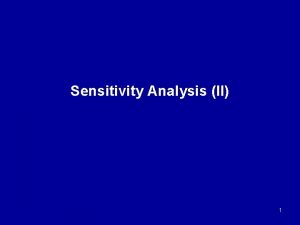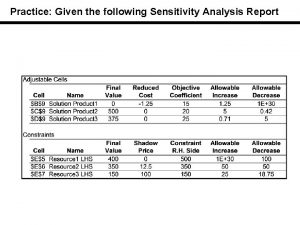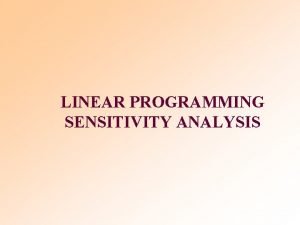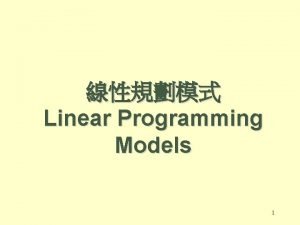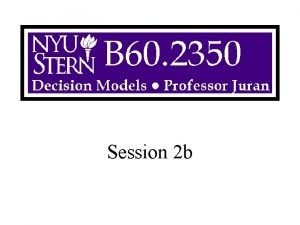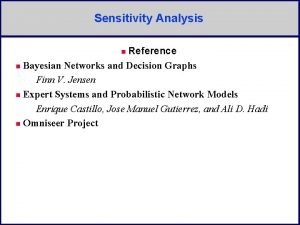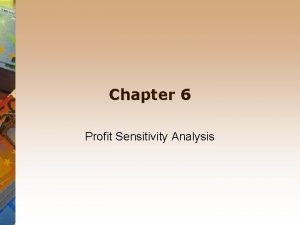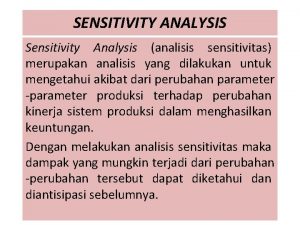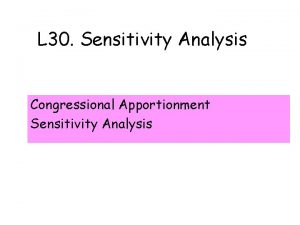Practice Given the following Sensitivity Analysis Report Sensitivity






- Slides: 6

Practice: Given the following Sensitivity Analysis Report

Sensitivity Analysis • • • What is the optimal objective function value for this problem? 0(15) 500(20) a. It cannot be determined from the given information. 375(25) b. $900. = 19375 c. $987. 5. (e) d. $875. e. $19375. What is the allowable range for the objective function coefficient for Product 3? a. 0. 71 ≤ P 3 ≤ 5. 25+0. 71 = 25. 71 b. 20 ≤ P 3 ≤ 25. 71. 25 -5 = 20 c. 0. 71≤ P 3 ≤ 25. 71. 20 to 25. 71 d. 25 ≤ P 3 ≤ 25. 71. (b) e. non of the above. What is the allowable range of the right-hand-side for Resource 1? a. 500 ≤ RHS 1 ≤ ∞. 500+ ∞ = ∞ b. 0 ≤ RHS 1 ≤ 500 -100=400 c. 100 ≤ RHS 1 ≤ ∞. 400 to ∞ (d) d. 400 ≤ RHS 1 ≤ ∞. e. -∞ ≤ RHS 1 ≤ 400.

Sensitivity Analysis • • • If the coefficient for Product 2 in the objective function changes to $24, then the objective function value: Product 2: 20 24 a. will increase by $24. 4 is within the range Final values remain the same b. will increase by $120, 000. Instead of 500(20) we will have 500(24) c. will increase by $2000. 500(4) = 2000 increase d. will remain the same. (c) e. can only be discovered by resolving the problem. If the coefficient for Product 1 in the objective function changes to $5, then the objective function value: Product 1: 15 5; 10, a. will increase by $5. allowable decrease ∞ 10 is within the range; Final values remain the same b. is $0. Still we produce 0 units of product 1 c. will increase by $10. The objective function will remain the same d. will remain the same. (d) e. can only be discovered by resolving the problem. If the coefficient of Product 2 in the objective function changes to $15, then: a. the original solution remains optimal. b. the problem must be resolved to find the optimal solution. c. the optimal solution will decrease by 2500. Product 2: 20 15 d. the shadow price will decrease by 5. 5 is out of range (b) e. the optimal solution will increase by 2500.

Sensitivity Analysis • If the right-hand side of Resource 1 increases, then the objective function value: a. will increase. R 1 b. will decrease. R 1 ∞ Any change then is within the range c. will decrease then increase. Shadow prices will remain the same; still 0 d. will remain the same. Therefore, no change in the objective function e. will increase then decrease. (d) • If the right-hand side of Resource 2 changes to 370, then the objective function R 2 from 350 to 370 value: 20 allowable increase 50 a. will increase by $370. Within the range b. will increase by $350. Shadow prices will remain the same; still 12. 5 c. will increase by $250. 20(12. 5) = 250 (c) d. will remain the same. e. can only be discovered by resolving the problem. • If the right-hand side of Resource 3 changes to 130, then: a. the original solution remains optimal. b. the problem must be resolved to find the optimal solution. c. the objective function will decrease by 130. R 2 from 100 to 130 30 out of range d. the objective function will decrease by 3000. (b) e. the objective function will increase by 3000

More than one profit OR More than one resource • If the sum of the ratio of (Change)/(Change in the Corresponding Direction) <=1 • Things remain the same. • If we are talking about profit, the production plan remains the same. • If we are talking about RHS, the shadow prices remain the same.

Sensitivity Analysis • • • If the objective coefficients of Product 1 is increased by 1 and the objective coefficient of product 3 is decreased by 2, then: P 1: 1, P 3 2 P 1 1. 25, P 2 5 a. the objective function will decrease. (1/1. 25)+(2/5) >1 b. the objective function will increase. (e) c. the optimal solution will remain the same. d. the shadow prices will remain the same. e. can only be discovered by resolving the problem. If the right-hand side of all three resources, each increases by 10 units: a. the optimal solution remains the same. The objective function value will increase. b. the optimal solution will change. The objective function value will increase. R 1, R 2, R 3: 10 c. the optimal solution and the shadow prices will remain the same. d. the optimal solution and the shadow prices both will change. R 1 ∞, R 2 50, R 3 25 10/ ∞ + 10/50+10/25 ≤ 1 e. can only be discovered by resolving the problem. Shadow prices will remain the same If the right-hand side of resouses 1 and 2 each decreases 0(10)+12. 5(10)+100(10) = 1125 (b) by 20 and the right hand side of resource 3 increases by 5: a. the objective function value will increase by 250. R 1 20, R 2 20, R 3 5 R 1 100, R 2 50, R 3 25 b. the objective function value will decrease by 250. 0. 4+0. 2 ≤ 1 c. the objective function value will remain the same. Shadow prices will remain the same d. the optimal solution will remain the same. 0(-20)+12. 5(-20)+100(5) = 250 e. can only be discovered by resolving the problem. (a)
